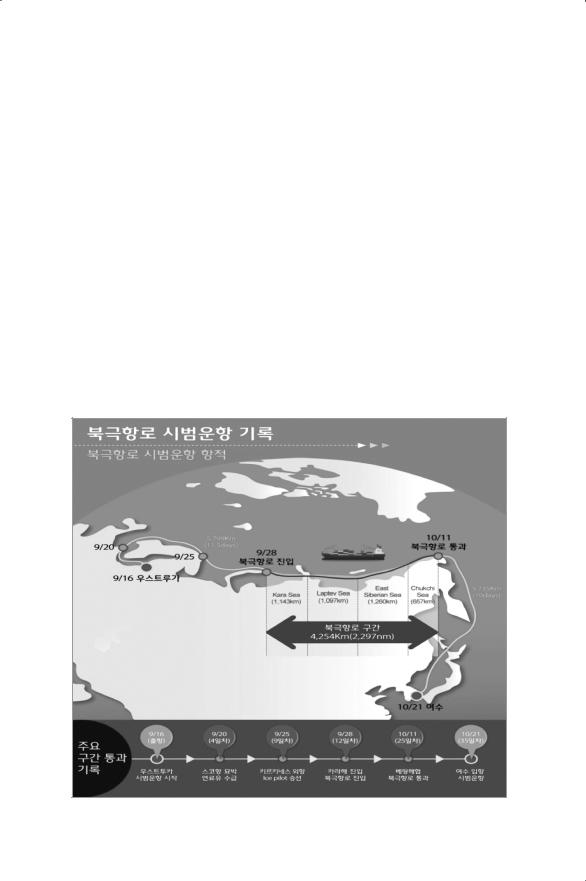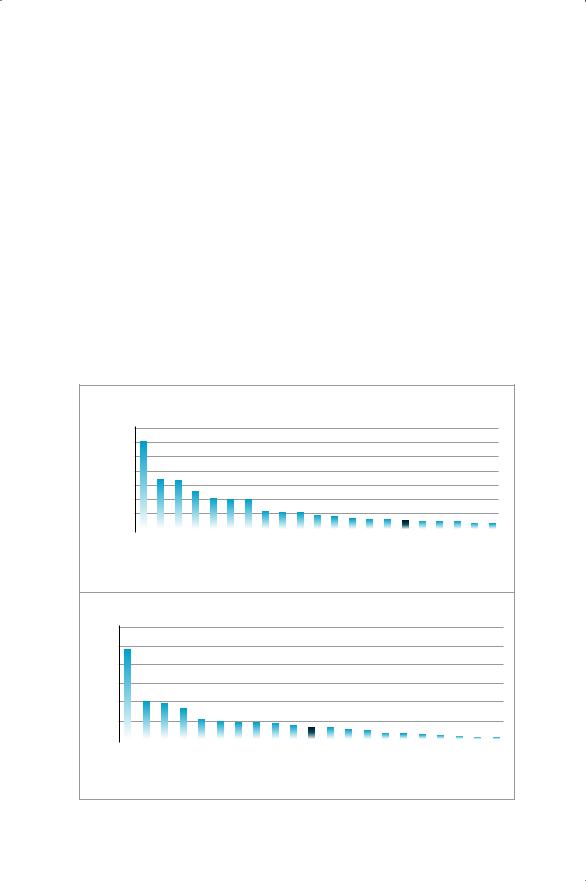
NPAC 2014 Proceedings_final
.pdf
204 |
Comparing National Arctic Policies |
business.
The pillar of science is less traditional compared to the pillar of diplomacy since most of its activities began in the 1990s. Its main actors have been MEXT, NIPR and JAMSTEC. These three take a leading role in the current GRENE Arctic Climate Change Research. The driving force within the pillar has been the improvement of scientific knowledge, which was centered on Arctic-related measures in the Basic Plan. In this sense, the pillar of science has been the core of the Japan’s Arctic policy. In terms of linkages, the second plan clearly stipulated, rather than promoting itself, to promote the pillar of business, namely future use of the Arctic Sea Route, by conducting experimental tests for sea ice flash charts and the AIS system. The prospects of this pillar are in maintaining the current status quo rather than initiating new activities.
The pillar of business, beginning with the KANUMAS Project in the 1990s, is less traditional than the pillar of diplomacy. The main actors are the Japan Oil Corporation or JOGMEC and MLIT. This pillar is becoming thick after MLIT constituted its own Arctic agenda in 2012. The increasing importance of this pillar can be observed in the fact that the pillar of science was called on to promote this pillar in the plan. As to its prospects, there is an increasing possibility that METI will become an important actor within the government in terms of the pillar of business.
So far, how do we perceive the strategy of Japan’s Arctic policy as a whole? Based on the fact that there has been no independent formulation of an Arctic strategy or Arctic policy, hints are in the relationship of the three pillars. As this article shows the formation of three pillars resulted from sporadic and self-sustained projects taken by several ministries and semigovernmental entities. Therefore, in the period before the second plan was adopted, it was hard to see a common and consistent strategy throughout the three pillars. However, these three have been important driving forces developing Japan’s Arctic policy.
The decisive step in terms of a strategy was taken with the inception of the second Basic Plan on Ocean Policy, although the impact of the Basic Plan should not be exaggerated, since the portions on Arctic-related measures were categorized as “remnants” compared to the agenda for other than Arctic affairs. Taking note of this weak foundation in the plan, this article examined the three pillars in the plan and revealed the linkages among the three pillars. With these linkages, it is possible to contend that the plan produced a strategy for Japan’s Arctic policy. The main features of

Japan’s Arctic Policy |
205 |
the strategy are:
•to maintain each pillar as self-sustained,
•to utilize the pillar of science for the pillar of business, and
•to make efficient use of the pillar of diplomacy for the pillar of science.
These three elements are in essence the way in which Arctic policy has been conducted until now and also constitute the main vision for the future. However, since this strategy was defined mainly in the context of ocean policy, it has limited its focus to ocean-related activities. This tendency may change to take into consideration terrestrial dimensions. The promising categories are in the pillar of business and diplomacy. Therefore, it is fair to conclude that with the development of the terrestrial dimension the strategy will be complete, and then the Arctic policy of Japan will have a more sound foundation. The coming years will for nourish the current Arctic Policy toward becoming more balanced and comprehensive.
Notes
1.“Ocean Industries” means those industries bearing on the development, use and conservation of the oceans (Art. 6 of the Basic Act on Ocean Policy).
2.Other measures are: promotion and creation of marine industries; securing safety and security on the oceans; promotion of marine surveys and integration and disclosure of marine-related information; developing human resources and improving technological ability; and comprehensive management of sea areas and formulation of plans.
3.Personal interview with MLIT official, March 28, 2014.
4.Ibid.
5.Personal interview with MoFA official, February 7, 2014.
6.The author participated.

206 |
Comparing National Arctic Policies |
References
GUES. 2005. “Exploration History,” 1 February, http://www.geus.dk/DK/archive/ ghexis/Sider/expl-his.aspx (accessed 22 July 2014).
METI. 2013. “Minister Motegi Visited Russia,” 27 December, http://www.meti.go. jp/english/ press/2013/1227_01.html (accessed 22 June 2014).
MoFA. 2013. “Hokuou Baruto Hachikakoku Tono Gaishokyu Kaidan: Gaiyo to Hyouka (the meeting at the foreign minister level with the Nordic and Baltic eight countries),” [In Japanese.] 11 November, http://www.mofa.go.jp/mofaj/ kaidan/ page18_000107.html (accessed 7 June 2014).
Ohnishi, Fujio. 2014. “The Process of Formulating Japan’s Arctic Policy: from Involvement to Engagement.” In Kimie Hara and Ken Cotes, ed. East AsiaArctic Relations, Boundary, Security and International Politics (Waterloo: Center for International Governance Innovations), 31-41.
Russian-Japanese Organization for Trade and Investment Promotion. 2014. “Preliminary Results of the 6th Japan-Russia Investment Forum. [In Japanese.] Last modified March 20. http://www.jp-ru.org/6forum/kekkagaiyou.pdf (accessed 22 June 2014).
The Government of Japan. 2013. Basic Plan on Ocean Policy. A Provisional Translation. April. 34.
Tonami, Aki and Stewart Watters. 2012. “Japan’s Arctic Policy: The Sum of Many Parts.” In Lassi. L. Heinine, ed. Arctic Yearbook 2012 (Akureyri: Northern Research Forum), 93-103.
Vivero, Juan L. Suarez De. 2007. “Marine Policy: Europe and Beyond,”
Willamamtte J. Int’L. & Dis. No.15, 167-181.

9.Korea’s Arctic Policy
Jong Deog Kim
INTRODUCTION1
After Korea implemented the “National Development Plans” for modernization in the 1960s, the Korean economy flourished from foreign trade that mainly relied on shipping logistics. Some of the main factors were a lack of natural resources, insufficient domestic demand, and limitation of land transportation with other countries. This economic structure can be found even to this day.
In the 1970s and 1980s, development policies were focused on the heavy chemical industry, leading to growing shipbuilding, steel, construction, and oil refining businesses, and allowing the Korean manufacturing industry to gain the upper hand in international competition. As trade proliferated in the 1990s, social overhead capital such as harbors, airports and telecommunications networks evolved. Busan Port and Incheon Airport grew to become the key bases for goods and transportation in Northeast Asia, and the nation’s communication technology (ICT) including the Internet became one of the best in the world. Steady growth continued from the year 2000 in high value-added industries such as semiconductors, telecommunication devices, automobiles, special shipbuilding, etc. Market share in these sectors grew even in new regions such as China, Southeast Asia and South America.
Unfortunately, several key issues remain unresolved, such as the lack of natural resources, an unbalanced energy supply system, and a weakened logistics competitiveness system. Overcoming these problems will strengthen Korean industrial competitiveness and enable a long-term sustainable economy. Therefore, considering Korea’s current economic structure, opportunities in the Arctic are significant. It is predictable that Arctic affairs will become a more important national interest for Korea in the future.
Since 2005, some scientific studies have shown that unstable climate conditions and ecosystem changes in Korea and its neighboring seas are closely connected to changes in the Arctic region, which has led to increased
207

208 |
Comparing National Arctic Policies |
Central
Asian-Indian
Flyway
 West
West
Paci c
Flyway
East Asian-Australian Flyway 
Figure II-3. Asia migratory bird flyways2
concerns about the effects of being geographically located near the Arctic. In particular, abnormal weather during the winter and spring season is affecting agriculture, fisheries, and large ecosystems, posing a long-term threat to natural security.
The climatic, environmental, economic and social changes surrounding the Arctic since the 1990s became a new global challenge in the 21st century. The Arctic Council was founded in 1996 by eight Arctic states and various indigenous groups, and aims to promote environmental protection and sustainable development in the Arctic. Specific action plans have been established since then by the six Working Groups and Task Forces to meet the goals of the Arctic Council.
The drastic shrinking of Arctic sea ice in 2007 and a report from the US Geological Survey in 2008 on resources in the Arctic region initially triggered an immense amount of attention from the world. Ironically, such changes and resources caught the attention not only of the eight Arctic nations, but also Asian countries such as China, Japan, and Korea, which are directly (and indirectly) involved in Arctic issues–climate change, environmental pollution, scientific research, shipping, and economic development–and are also the key global players in meeting technological challenges such as shipbuilding and offshore plant facilities in the Arctic.
In addition, the aforementioned nations play a significant role as

Korea’s Arctic Policy |
209 |
both suppliers and consumers in the areas of resources, construction, telecommunications and the tourism market that are strongly related to sustainable development in the Arctic. The High Seas of the Central Arctic Ocean constitute a zone of free navigation under the UN Convention on the Law of the Sea (UNCLOS), meaning that non-Arctic nations can claim rights as interested parties in some parts of the Arctic Ocean.
Korea pursued a globalization policy due to political democratization during the 1990s. With an underlying policy of national development through an increase in economic activities and sustainable development through green growth, Korea tries to perform its duties as a member of the G20 and of the global community in the 2000s. With the establishment of the Ministry of Oceans and Fisheries (MOF) in 1996, efforts are underway to achieve an integrated ocean policy, including enhancing R&D to create stronger marine science and technology competitiveness and to develop Korea as a hub area of the shipping service industry in Northeast Asia.
The Arctic region poses new challenges–bringing collective benefits through cooperation, sharing responsibility in Arctic environmental protection and sustainable development, and reducing threats using state- of-art technology.
KOREA’S ARCTIC POLICY IN THE PAST
Korea’s involvement with the Arctic affairs began with fisheries in the 1960s. According to the records, trawl fishing in the Bering Sea in 1966 was officially the first Arctic-related activity. But under 1994 by the Convention on the Conservation and Management of Pollock Resources in the Central Bering Sea (CBSPC), whose signatories are Korea, the United States, Russia, Poland, China, and Japan signed the treaty, the pollock fishery is suspended unless and until the stocks recover.
In the 1990s, Korea took up the challenge of exploring the North Pole. The AURORA exploration team sought to reach the North Pole, but failed in their first trial in 1990. In the following year, however, the AURORA team reached the North Pole after departing from the Ward Hunt Island in Canada. This was the 11th nation and 18th team to reach the North Pole, and the expedition was aired live on TV through satellite. Reaching the North Pole by the AURORA team created a deep impression on the Korean people regarding the future potential of the Arctic.

210 |
Comparing National Arctic Policies |
Scientific efforts began in the late 1980s. In 1987, the Polar Research Laboratory (PRL) was founded within the Korea Ocean Research and Development Institute (KORDI), and in 1993, Korea participated in an Arctic research project with the Polar Research Institute of China (PRIC). In 1999, Korea joined the Okhotsk marine research effort with the Geological Survey of Japan’s National Institute of Advanced Industrial Science and Technology (AIST). In the same year, Korea also joined the Chinese research icebreaker, Xue Long, for an Arctic expedition. Solo research by Korea officially took off with the establishment in 2002 of the DASAN Arctic Research Station in Ny-Ålesund on Svalbard where scientists conduct research on climate change and biodiversity and observe the changes in the Arctic. In 2000, as part of the Korean MOF’s research program, a joint marine investigation was conducted in the Barents Sea and Kara Sea with Russia’s Arctic and Antarctic Research Institute (AARI). In 2002, Korea joined the International Arctic Science Committee (IASC).
The most significant change in Arctic research was brought about by the establishment of the Korea Polar Research Institute (KOPRI) in 2004 and construction of a research icebreaker, the Araon, in 2009. KOPRI operates three polar research stations and the Araon. Sized at 7,487GRT, the Araon can sail at 3 knots in 1 meter of ice and is used in global maritime research in the Arctic and Antarctica. Capable of carrying a 6.1 meter container and 7 meter working boat, the vessel exemplifies Korean polar research.
Responses in the policy field took reached a new level in 2008 when Korea applied for observer status with the Arctic Council. The drastic change in the Arctic sea ice in 2007 raised socioeconomic concerns in Korea. Since then, several research studies have been conducted relating to the Northern Sea Route (NSR) and resource development cooperation. In 2012, Korea acceded to the Treaty of Spitsbergen, and the president of Korea visited Greenland and Norway for the first time to officially announce to the international community Korea’s interest in cooperation in the Arctic. In 2013, the new administration also designated Arctic cooperation as one of the key national agenda items. When Korea became an observer in the Arctic Council at the Ministerial Meeting held at Kiruna, Sweden in 2013, it triggered the country to take on a pan-governmental approach to Arctic policy. Previously, only sectoral projects were pursued by each government agency and research institute. The Master Plan (discussed later in this article) is the first integrated policy coordinated

|
|
|
Korea’s Arctic Policy |
|
211 |
Table II-4. Transits NSR to/via/from Korea 2011-2013 |
|
||||
|
|
|
|
|
|
No |
Vessel |
Flag |
Cargo |
Port Loading |
Port Destination |
|
|
|
|
|
|
1 |
Stena Poseidon |
Finland |
Gas Con. |
Vitino, RUS |
Incheon |
2 |
Perseverance |
Singapore |
Naphtha |
Yeosu |
Le Havre, FRA |
3 |
Mariann |
Norway |
Gas Con. |
Vitino, RUS |
Incheon |
4 |
Marilee |
Norway |
Gas Con. |
Murmansk, RUS |
Incheon |
5 |
Stena Poseidon |
Finland |
Jet fuel |
Yeosu |
Porvoo, FIN |
6 |
Palva |
Finland |
Gas Con. |
Murmansk, RUS |
Daesan |
7 |
Marika |
Norway |
Jet fuel |
Yeosu |
Porvoo, FIN |
8 |
Marinor |
Norway |
Gas Con. |
Murmansk, RUS |
Daesan |
9 |
Stena Poseidon |
Finland |
Gas Con. |
Murmansk, RUS |
Daesan |
10 |
Palva |
Finland |
Jet fuel |
Yeosu |
Porvoo, FIN |
11 |
Two Million Ways Cyprus |
Gas Con. |
Murmansk, RUS |
Incheon |
|
12 |
Marika |
Norway |
Gas Con. |
Murmansk, RUS |
Yeosu(?) |
13 |
Ob River |
Marshall Is. |
Ballast |
Yeosu |
Montoir, FRA |
14 |
Maribel |
Norway |
Gas Con. |
Murmansk, RUS |
Daesan |
15 |
Marinor |
Norway |
Gas Con. |
Murmansk, RUS |
Daesan |
16 |
Yong Sheng |
Hong Kong |
General cargo |
Busan |
Rotterdam, NDL |
17 |
Vengery |
Russia |
Reposition |
Busan |
Murmansk, RUS |
18 |
Propontis |
Greece |
Gas oil |
Ulsan |
Skagen, DEN |
19 |
Stena Polaris |
Bermuda |
Naphtha |
Ust-Luga, RUS |
Yeosu |
20 |
Zaliv Amurskiy |
Cyprus |
Gas oil |
Onsan(Ulsan) |
Rotterdam, NDL |
21 |
Viktor Bakaev |
Liberia |
Jet fuel |
Yeosu |
Rotterdam, NDL |
22 |
Zaliv Baikal |
Liberia |
Naphtha |
Ust-Luga |
Yeosu |
|
|
|
|
|
|
by various governmental agencies rather than a single unified national strategy. The Ministry of Oceans and Fisheries became a leading agency in implementing this Master Plan.
Meanwhile, Korea’s observer status with the Arctic Council received much attention by the domestic media. Many of the articles noted, with enthusiasm, that Korea will have the opportunity to participate actively and cooperate with the global society’s response to the Arctic and gain economic benefits through access to Arctic resources and the NSR. On the other hand, concerns have also been raised with regard to potential negative effects of Arctic changes on the Korean environment and economy. As risks and challenges in Arctic development were perceived, the role of technological capacity-building in overcoming them became more

212 |
Comparing National Arctic Policies |
prominent.
In the Arctic shipping business, Korea plays a significant role already. Considering the 158 NSR transits from 2011 to 2013, Korea was either the departing or arrival port for 22 of these transits, second only to 25 in the case of China. Korea was already in the fast lane for the first commercial test voyage of the NSR between Ulsan and Rotterdam in 2009 by the Beluga Shipping Company of Germany, which did not stop in Russia. Oil products such as jet fuel, have been transported to the European market through the NSR several times.
In October 2013, Hyundai Glovis, a Korean logistics company, for the first time ever, completed a commercial test voyage in the NSR. The Stena Polaris of Sweden began its voyage from Ust-Luga in Russia and transported 44,000 tons of naphtha to the Yeosu-Gwangyang Port in Korea. It is expected that more Korean companies will use the NSR for commercial purposes under international guidelines and regulations similar
Figure II-4. Hyundai Glovis test voyage on NSR in 20133

Korea’s Arctic Policy |
213 |
to other countries. The experiences of the test voyages will contribute much to the development of feasible shipping via the NSR. Additional test voyages by multiple Korean companies are expected in 2014. And the recent contract between DSME and Yamal LNG to build icebreaking LNG carriers will benefit Korea symbolically in the realm of Arctic development.
Figure II-5 illustrates the results of searching Internet for the word “Arctic.” There were a total of 11 million web hits, with “Korea + Arctic” ranking 16th among the 20 Arctic and non-Arctic states associated with the Arctic Council, whereas news hits ranked 11th, indicating that there is more interest from the media. The increase is especially notable since obtaining observer status with the Arctic Council; there has been a significant increase of interest by local media, along with competition among domestic ports to utilize the NSR by local governments.
Google Web hits (6.11)
140,000,000
120,000,000
100,000,000
80,000,000
60,000,000
40,000,000
20,000,000
0
'%!%%%
+,!,%%+,!'%% *'!-%%
|
|
|
|
|
|
|
|
|
|
)'!*%%)%!(%% |
(%!%%% |
|
|
|
|
|
|
|
|
|
|
|
|
|
|
|
|
|
|
|
|
|
|
|
|
|
|
|
|
|
|
|
|
|
|
|
|
|
|
|
|
|
|
|
|
|
|
|
|
||||||||
|
|
|
|
|
|
|
|
|
|
|
|
|
|
|
|
|
|
')!%%% ''!+%%''!)%% |
|
|
|
|
|
|
|
|
|
|
|
|
|
|
|
|
|
|
|
|
|
|
|
|
|
|
|
|
|
|
|
|
|
|
|
|
|
|
|
||||||||||
|
|
|
|
|
|
|
|
|
|
|
|
|
|
|
|
|
|
|
|
|
|
|
|
|
|
|
|
&-!.%%&+!)%%&(!)%%&(!%%%&'!*%%&&!%%%&%!,%%&%!)%% |
|
|
|
|
|
|
|
|
|
|
|
||||||||||||||||||||||||||||
|
|
|
|
|
|
|
|
|
|
|
|
|
|
|
|
|
|
|
|
|
|
|
|
|
|
|
|
|
|
|
|
|
|
|
|
|
|
|
|
|
|
|
|
|
|
|
|
|
|
|
|
|
|
|
|
|
|
|
|
||||||||
S |
|
|
A |
|
K |
|
A |
|
|
IA |
|
E |
|
U |
|
|
N |
|
|
|
A |
|
Y |
|
Y |
|
Y |
|
|
N |
|
D |
|
|
|
N |
|
|
A |
D |
|
|
|
|
S |
|
|
K |
|
|
|
E |
|
|
ND |
||||||||||||
U |
|
AD |
U |
CH |
|
|
|
RANC |
E |
JAPA |
|
|
SI |
NORWA |
|
|
|
PAI |
|
|
|
DE |
|
E |
L |
|
|
D |
MAR |
|
OR |
|
|
|
|||||||||||||||||||||||||||||||||
|
|
|
|
|
|
|
|
|
|
S |
|
|
|
|
|
|
|
|
|
|
|
|
|
|
|
|
|
|
|
|
A |
||||||||||||||||||||||||||||||||||||
CA |
|
|
|
IN |
|
|
|
|
|
|
|
|
|
|
|
|
|
|
|
|
|
SW |
|
|
|
FINLANER |
|
|
|
EN |
N |
|
|
|
|||||||||||||||||||||||||||||||||
|
|
|
|
|
|
|
|
|
|
|
|
|
|
|
|
|
|
|
|
|
|
|
|
|
|
|
|
|
|
|
|
|
|
|
|
|
|
|
|
|
|
|
|
|
|
GA |
|
|
P |
|
|
|
|
|
|||||||||||||
|
N |
|
|
|
|
|
IND |
|
|
|
|
|
|
|
|
|
|
GERMA |
|
|
ITAL |
|
ICELAN |
E |
|
|
KOR |
|
|
|
|
AN |
|
|
|
|
|
|
L |
|
|
|
|||||||||||||||||||||||||
|
|
|
|
|
|
|
|
|
|
|
|
F |
|
|
|
|
|
|
|
RU |
|
|
|
|
|
|
|
|
|
|
|
|
|
|
NETH |
|
|
D |
|
|
SI |
|
|
|
|
|
O |
|
|
|
|
||||||||||||||||
|
|
|
|
|
|
|
|
|
|
|
|
|
|
|
|
|
|
|
|
|
|
|
|
|
|
|
|
|
|
|
|
|
|
|
|
|
|
|
|
|
|
|
|
|
|
|
|
|
|
|
|
|
|
|
|||||||||||||
|
|
|
|
|
|
|
|
|
|
|
|
|
|
|
|
|
|
|
|
|
|
|
|
|
|
|
|
|
|
|
|
|
|
|
|
|
|
|
|
|
|
|
|
|
|
|
|
|
|
|
|
|
|
|
|
|
|
|
|
|
|
|
|
|
|||
60,000
50,000
40,000
30,000
20,000
10,000
0
Google News hits (6.11)
)-!(%%
|
'%!(%% &.!)%% |
&+!)%% |
|
|
|
|
|
|
|
|
|
|
|
|
|
|
|
|
|
|
|
|
|
|
|
|
|
|
|
|
|
|
|
|
|
|
|
|
|
|
|
|
|
|
|
|
|
|
|
|
|
|
|
|
|
|
|
|
|
|
|
|
||||||
|
|
|
|
|
|
|
|
&&!%%% .!+'% |
.!&'% |
|
-!-,% -!+*% ,!*'% |
|
|
|
+!(.% |
*!(,% |
|
|
|
|
|
|
|
|
|
|
|
|
|
|
|
|
|
|
|
|
|
|
|
|
|
|
|
|
|
|
|
|
|
|||||||||||||||||||
|
|
|
|
|
|
|
|
|
|
|
|
|
|
|
|
|
|
|
|
|
|
|
|
|
|
|
+!*%% |
)!--% |
(!)&% '!.'% |
'!++% |
'!')% |
&!,.% &!(,% |
|
|
|
|||||||||||||||||||||||||||||||||
|
|
|
|
|
|
|
|
|
|
|
|
|
|
|
|
|
|
|
|
|
|
|
|
|
|
|
|
|
|
|
|
|
|
|
|
.*% |
|
|||||||||||||||||||||||||||||||
|
|
|
|
|
|
|
|
|
|
|
|
|
|
|
|
|
|
|
|
|
|
|
|
|
|
|
|
|
|
|
|
|
|
|
|
|
|
|
|
|
|
|
|
|
|
|
|
|
|
|
|
|
|
|
|
|
|
|
|
|
|
|
||||||
S |
|
K |
|
A |
|
A |
|
|
IA |
|
|
|
A |
EU |
|
|
N |
|
|
|
N |
|
E |
|
|
|
A |
|
Y |
|
Y |
|
|
Y |
|
|
|
D |
|
D |
|
|
|
|
N |
|
|
|
S |
|
|
D |
|
|
|
K |
|
|
|
E |
||||||||
U |
|
U |
|
|
|
|
|
|
|
|
|
SI |
|
A |
P |
|
|
|
|
|
E |
N |
|
|
|
|
|
|
|
AN |
|
|
|
|
DE |
|
|
|
|
D |
AN |
|
|
|
|
|
|
OR |
||||||||||||||||||||
|
|
CANAD |
|
IN |
|
|
|
|
|
|
|
|
|
|
|
|
|
FRANC KOR |
|
|
NORWA |
|
|
|
PO |
|
|
SW |
|
|
|
|
|
|
|
|
|
|
|
|
||||||||||||||||||||||||||||
|
|
|
|
|
|
S |
|
|
|
P |
|
|
AI |
|
|
|
|
|
|
|
FINLAN |
|
|
|
R |
|
|
IC |
|
|
|
N |
|
|
NG |
|
|
|
|
|
||||||||||||||||||||||||||||
|
|
|
|
|
|
|
|
|
|
|
|
|
|
|
|
|
|
|
|
|
|
|
|
|
|
|
|
|
|
E |
|
|
|
|
|
|
|
E |
|
|
|
|
|
|
|
|
||||||||||||||||||||||
|
|
|
|
|
CH |
|
|
IND RU |
|
|
|
|
|
JA |
|
|
S |
|
|
|
|
|
|
|
|
|
|
|
|
|
|
ITAL |
|
L |
|
|
|
|
|
E |
|
|
|
L |
|
|
EL |
|
|
|
MAR A |
|
|
|
|
|||||||||||||
|
|
|
|
|
|
|
|
|
|
|
|
|
|
|
|
|
|
|
|
|
|
|
|
|
|
|
GERMA |
|
|
|
|
|
|
|
|
|
|
|
|
|
|
NETH |
|
|
|
|
|
|
|
D |
|
|
SI |
|
|
|
|
|
||||||||||
Figure II-5. Google hit number analysis as of June 11, 2014
